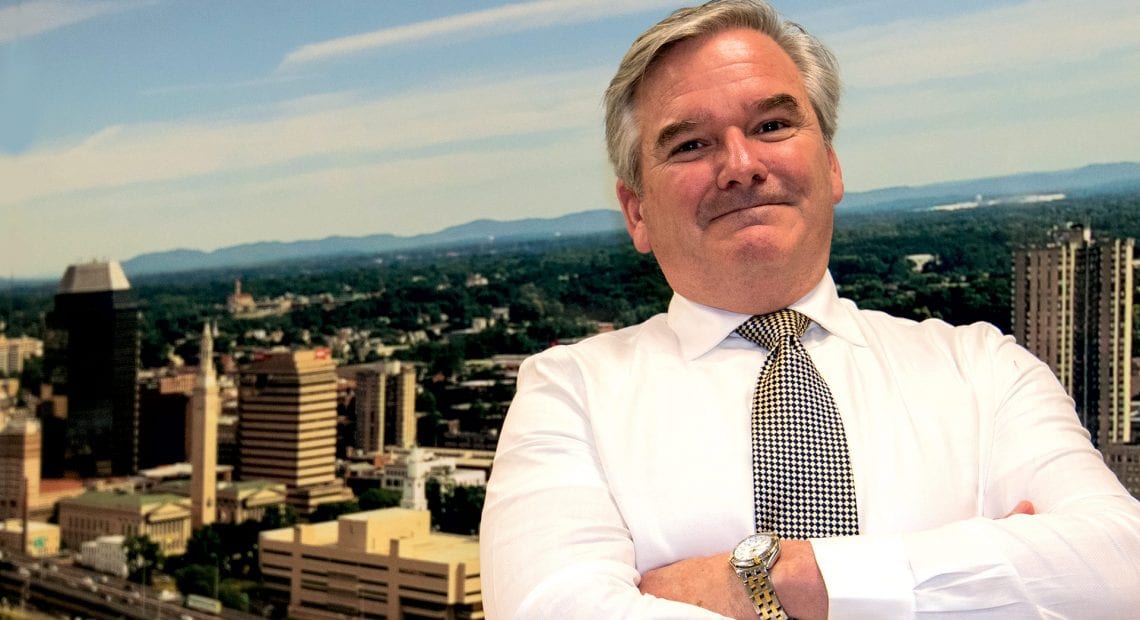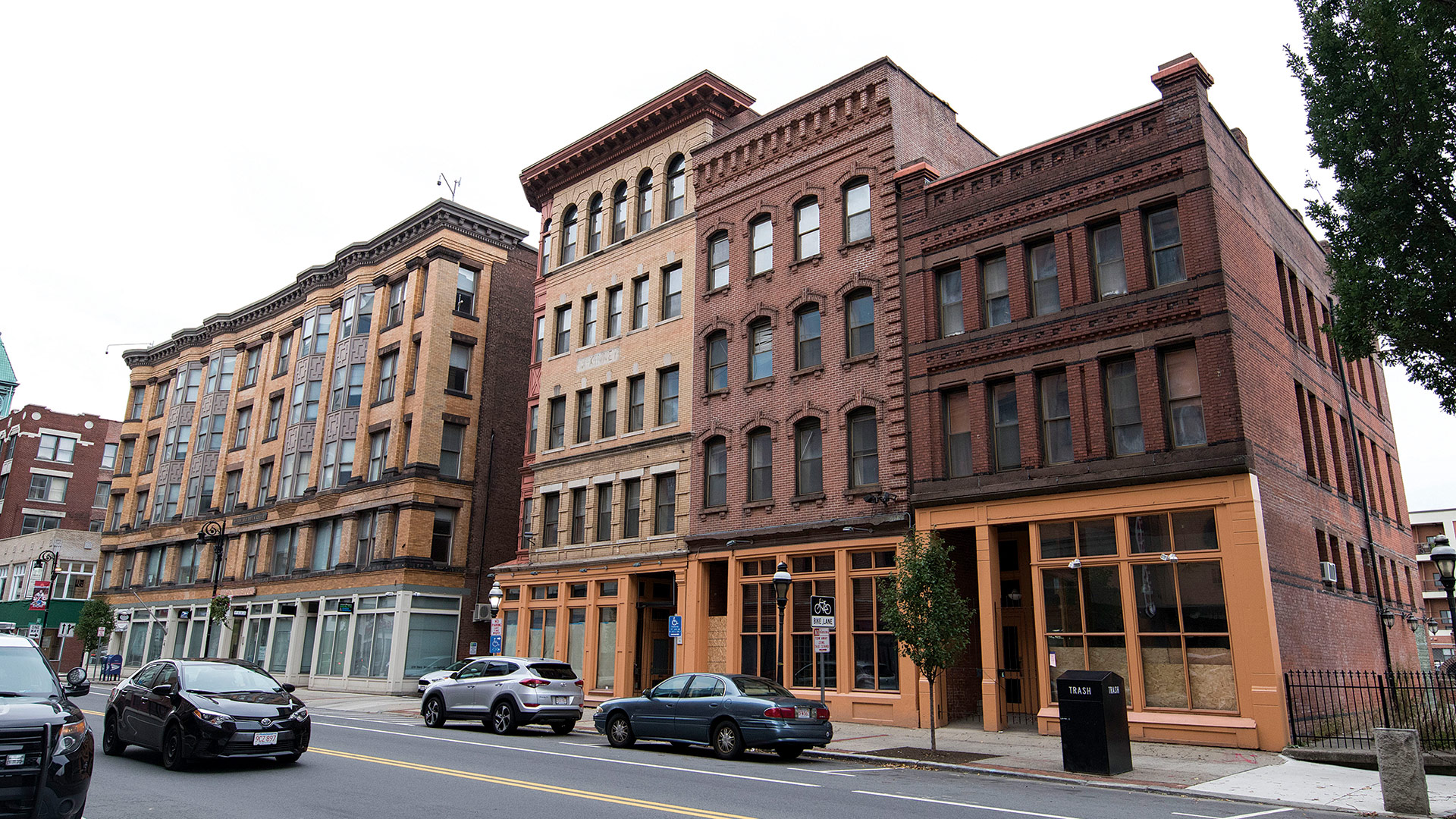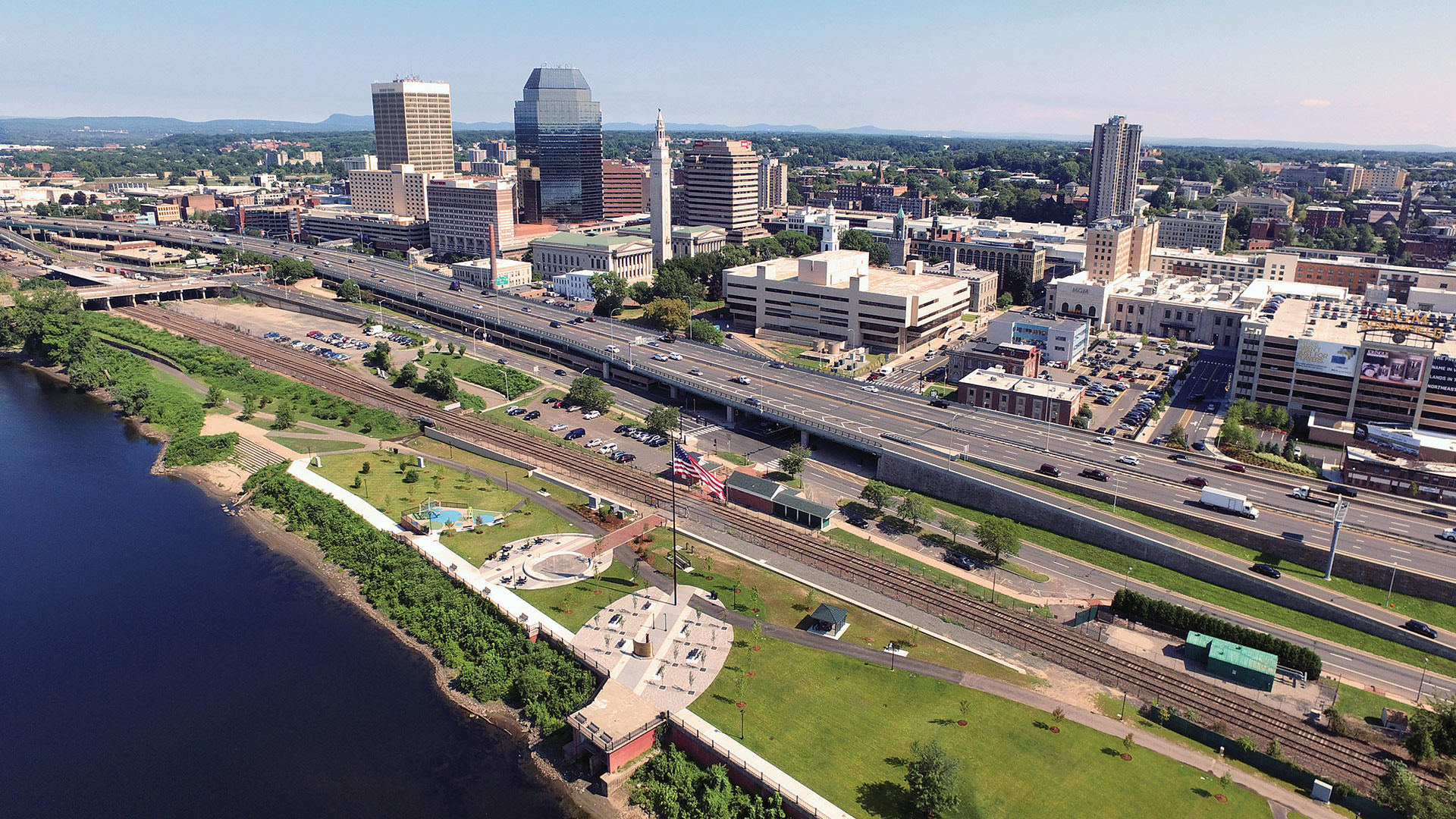
Development Chief Looks to Build on Momentum
The Next Steps for Springfield
Tim Sheehan, who succeeded Kevin Kennedy as Springfield’s chief Development officer in July, may be new to the job, but he’s certainly not new to the city. He grew up there, and later worked for two different mayoral administrations. In recent years, he’s seen the city go from the depths of receivership to what many are calling a renaissance. Looking to build off created momentum, he said there is still considerable work to do.
Tim Sheehan left Springfield, and a job with the state agency MassDevelopment, in 2002 to become director of the Redevelopment Agency in Norwalk, Conn.
But he didn’t exactly leave his birthplace behind.
Indeed, with a number of family and friends still living in and around the City of Homes, he returned frequently — at least once a month, by his estimate — and thus was keeping pace with all that happened in the city over that time.
That’s a lengthy list that includes everything from receivership to the opening of MGM Springfield to the revitalization, decades in the making, of Union Station, a project he’s quite familiar with because, starting in 2017, he took the train to Springfield for those visits.
So Sheehan didn’t have to reacquaint himself with the city, its challenges, and its opportunities when he accepted Mayor Domenic Sarno’s proposition to succeed Kevin Kennedy as Springfield’s chief Development officer.
In this important role, he has some big shoes to fill — Kennedy played a huge part in bringing more than $4 billion in development to the city since that tornado touched down in June 2011 — but also some momentum to build on and opportunities to add new chapters to an ongoing success story.
Indeed, while noting that considerable progress has been made with everything from vitality in the central business district to jobs to the city’s fiscal health, Sheehan concedes that much work remains to be done.
“There’s a very positive perception regarding where the city has positioned itself as a city within Western Mass.,” he said. “But there’s still room to grow on that, and I think Springfield can become a real leader in urban development.”
“The casino has met us a long way in the objective of encouraging people to go out from the casino and explore the city. What we need to do is take the next step so that there’s some sense of equivalence between what’s at the casino and what’s outside on Main Street.”
In no particular order, he listed the city’s many neighborhoods and needed work to revitalize the ‘Main Streets,’ if you will, of Indian Orchard, Forest Park, Six Corners, Boston Road, and even 16 Acres, where he grew up, as well as the need to create more market-rate housing in the city, a realm where he enjoyed success in Norwalk.
Sheehan also mentioned some specific projects that most might think of when they hear the term ‘economic development’ — 31 Elm St. was at the top of that list — and some initiatives they might not connect with that term, such as job training and assistance to small businesses, which are the backbone of the city’s economy.
“There are some studies that looked at employment and job-training initiatives in the city and discussed ways they could be improved,” he noted. “And there are studies that looked at how we could expand and assist the industrial and manufacturing sectors that exist here, and still others that look at the importance of the small-business sector within Springfield’s larger economy, the role it plays, and what government could provide to strengthen small business.
“As much as the large-scale development in the city has been fantastic and they’re a beacon to attract people,” he went on, citing MGM, CRRC, and other eight- and nine-figure projects, “we can’t lose sight of the fact that the smaller businesses — employers with fewer than six people — are the vast majority of the businesses, and they contribute significantly to the economic health of the city.”
And then, there’s MGM Springfield, or what’s happening across the street from it, to be more precise. Actually, it’s what’s not happening that needs to be addressed moving forward, said Sheehan, citing the need for balance or ‘equivalence,’ as he put it.
“The casino has met us a long way in the objective of encouraging people to go out from the casino and explore the city,” he explained. “What we need to do is take the next step so that there’s some sense of equivalence between what’s at the casino and what’s outside on Main Street.”
For this issue, BusinessWest talked at length with Sheehan about his return to Springfield and how he intends to help build on the positive energy that’s been created and take the city to a still-higher plane.
Tracking Results
Looking out the windows of the train during those trips from New Haven, Sheehan said he could certainly see progress coming to the city he grew up in — and not just in the gleaming casino taking shape in the South End.
He noted improvement in everything from the entertainment district to parks; from public safety to job creation.
But, as noted, there is still considerable work to do, he said, adding that the prospect of leading such efforts was enticing enough to make ‘chief Development officer, city of Springfield’ the next line on an already-intriguing résumé.
And, as mentioned, some of the earlier lines involve Springfield as well. Indeed, he worked for two mayors — Richard Neal (before he become Congressman Neal) and his successor, Mary Hurley, in the Community Development and Planning office.
From Springfield City Hall, Sheehan moved to work for the state at the Executive Office of Communities and Development, and later at MassDevelopment, both at that agency’s Boston office and its first regional office in Springfield, which he directed.
He enjoyed the work, but eventually he desired a return to working on the municipal level and in development work.
“At the time, MassDevelopment was doing a lot of community-development lending, and I was doing projects on the North Shore and Lawrence, and then projects in the Berkshires,” he recalled. “One of the problems, from my perspective, is that I was drifting toward being more of a banker and less of a hands-on community-development/economic-development person.”

While MGM is thriving, Tim Sheehan says, one of the challenges facing the city is the need to achieve what he calls ‘equivalence’ on the other side of Main Street, seen here.
He found an opportunity to get back to the latter in Norwalk, and its Redevelopment Agency, a broad, one-stop shop for planning, housing, and economic development.
In Norwalk, a city roughly half Springfield’s size (85,000 people), one of his biggest achievements involved increasing the number of market-rate housing units in and around downtown, thus growing the population in the central business district.
The city had a number of factors working in its favor as it went about this assignment, he noted, especially its proximity to New York and status as a bedroom community for Gotham.
“It’s an hour by train to Grand Central Station, and 45 minutes to be in Manhattan proper,” he said, adding that these numbers translate into a fairly attractive commute, thus making such projects doable from an economic perspective in terms of the prices developers could charge for such properties.
Springfield doesn’t have such geography working for it, he went on, adding quickly that it can take advantage of some demographic shifts, especially retiring Baby Boomers and Millennials both becoming more drawn to walkable cities and the amenities of urban living.
What’s more, the city has a large stock of older buildings, many of them architectural gems, that could be converted to market-rate housing, perhaps with retail or other uses on the ground floors.
“The architecture in Springfield is far beyond what new development would be able to accomplish today,” he noted. “What we would like to see is a dedicated effort to look at repurposing those buildings with residential uses.”
Still, the numbers have to work for developers to move forward with projects like the one now underway at the former Willys-Overland building, and in some cases, it might be challenging to make them work.
“Springfield has the capacity to absorb more market-rate housing, but I think there’s going to have to be some level of government support for that,” he said, citing statistics showing that, while Worcester added more than 600 new housing units between 2013 and 2017, Springfield added 230. “But these projects have to pencil out from an economic standpoint. That was a challenge in downtown Hartford, but both the state and the city stepped up to understand that.”
“The importance of having a downtown residential population is critical to the long-term economic viability of your municipality,” he went on, underscoring the importance of such initiatives. “This is one of the challenges that Springfield needs to address.”
Overall, the city needs to create much more of a balance downtown between market-rate housing and the large amounts of subsidized housing that still exist in the central business district, he said, adding that this has been a long-standing issue for Springfield and a key to continued revitalization.
“You can’t have all or mostly subsidized housing — that’s not good for your downtown,” he went on, adding that Springfield’s housing stock downtown has been out of balance for some time.
Down on Main Street
But housing is just one of the issues and challenges facing the city, said Sheehan, who returned to the subject of MGM Springfield and the work needed to match the glitter on the west side of Main Street with some on the east side.
At the moment, there is little if any glitter there, he said, noting that there are several vacant or underutilized properties in the shadow of the casino, and this is a situation that needs to be addressed if the property is to reach its full potential and become even more of a catalyst for development.
“You have to give a nod to MGM in terms of the architectural design of the casino — it was meant to be porous, and that’s atypical of casino design, but a net positive for Main Street in Springfield,” he noted. “But in order to have people traversing between Main Street and the casino, there needs to be a sense of equivalence on both sides of the street.
“If I didn’t necessarily want to stay on the casino floor and wanted to come out and see what downtown might have to offer, I’m inhibited from doing that by coming to the front door on Main Street, looking across the street, and seeing that there’s no ‘there’ there for me,” he went on. “I’m going to turn around and go back into the casino.”
Creating a ‘there’ will require private investment, he continued, adding that a consortium of investors have expressed some interest in taking on properties that are “not meeting their full potential.”

And while downtown and the blocks around MGM are certainly a priority for the city, Sheehan said, Springfield’s other neighborhoods need some attention as well, especially their main commercial districts.
“If you look at the neighborhood commercial corridors, there is a lot of work to be done,” and strengthening those corridors is a priority moving forward, he told BusinessWest, listing Main Street Street in Indian Orchard as one such corridor, the ‘X’ in Forest Park as another, and Boston Road, which he grew up near, as still another.
“If you look at Boston Road, there is significant vacancy there,” he said, referring not only to the Eastfield Mall and the exodus of stores there but the full length of that commercial thoroughfare. “It’s not the Boston Road I used to remember as a kid; there are some challenges there.”
Six Corners is another neighborhood corridor where improvement is needed and work is in progress, he said, noting the infrastructure work taking place there, especially a new roundabout designed to ease traffic flow in that area.
The hope is that such civic improvements there and elsewhere will generate private-sector investments, he went on, adding quickly that revitalization of neighborhoods such as Six Corners requires collaborative efforts among a number of parties — and healthy doses of imagination.
We’ve made a big investment in the public infrastructure there,” he said. “Now, we need to look at the sustainability of the businesses that exist there; we’re doing some early planning activity with regard to what commercial activity is appropriate for there.
“We’re also trying to get more engagement in these centers from the institutions that surround them,” he went on. “How can we engage better with AIC and Springfield College to ensure that the businesses that surround them are made more healthy by their populations?”
These projects are often much more difficult to undertake because they do involve private investment, he went on, adding that the public (government) side has to inspire such investments and make them easier through planning and a roadmap for the future.
“In order to entice the private developer to come to those areas, from the city’s perspective, you need to have a plan as to what you want to happen there, and you have to have everything aligned with that plan, so that, if I’m making the investment after reading your plan, I don’t have to deal with zoning in terms of having to change something to fit your plan; it’s already been done,” he explained. “I’ve read the plan, I understand what the city wants, and the city’s done all the heavy lifting to get my project approved.”
Along for the Ride
Talking about the train he took into Springfield, Sheehan raved about everything from the price of the ticket to how full the cars were — at least to the Hartford stop.
“The train is fantastic; the ability to go from Springfield to Hartford or Hartford to Springfield or New Haven to Springfield for $6 or $12 one way … that’s a bargain and a very convenient form of transportation,” he said, adding that the train has become a very attractive alternative to those not looking to battle the traffic on I-95 or I-91 on a Friday afternoon, or any afternoon, for that matter.
It’s not his official job description, but as chief Development officer, Sheehan’s goal is putting even more people on those trains coming into Springfield — professionals, tourists, and those, like him, coming to visit family and friends.
It’s also his job to give them not only more to see out the windows, but more to experience once the train pulls in.
It’s a challenge he certainly embraces, and one that brings his career full circle in many respects — back to the city he grew up in, and back to the city he wants to take the next level.
George O’Brien can be reached at [email protected]





